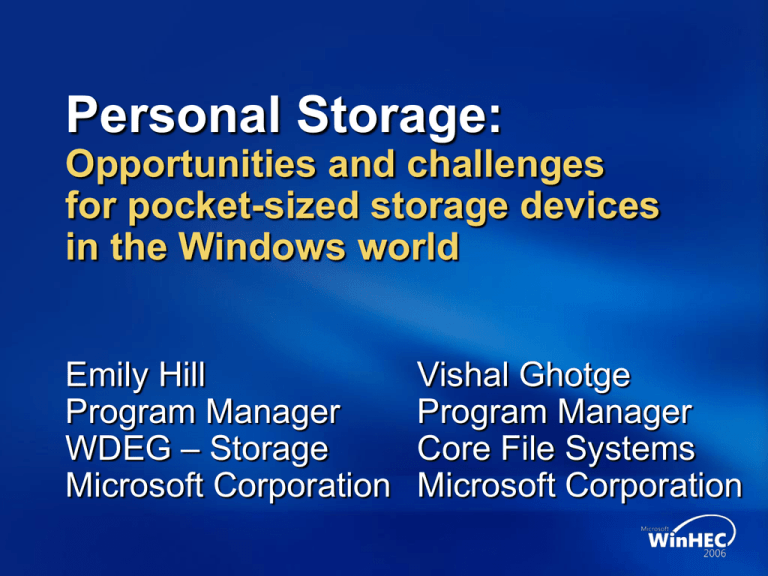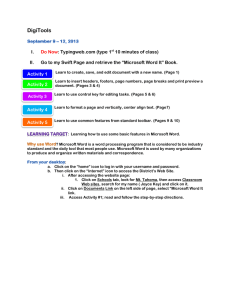
Personal Storage:
Opportunities and challenges
for pocket-sized storage devices
in the Windows world
Emily Hill
Program Manager
WDEG – Storage
Microsoft Corporation
Vishal Ghotge
Program Manager
Core File Systems
Microsoft Corporation
Windows Storage Devices
Strategic pillars
Storage Fabrics
Server/Enterprise
Leading platform enabling storage
fabric adoption
Optimized platform features
Personal Storage enabling your Windows
Client/Consumer
experience, here and now
Optical Platform
Client/Consumer
Preferred
Storage Platform
Partner/Customer
Timely, comprehensive, quality
platform support for optical devices
Preferred platform for
developing, deploying,
and using storage devices
Agenda
How is the Microsoft focus changing
for personal storage?
Windows Vista reflections of
those changes
Driver integration work
New scenarios enabled
Solutions to customer problems
Our thoughts for the future
New scenarios
Technology updates
What Is Personal Storage
Flash Cards
Small form
factor drives
UFDs
Smartcards
Cameras
Cell phones
Etc.
Size
Desktop
(non-portable)
Bus Speed
High Bandwidth
(1+gb/s)
PCs
Power
Supply
Independent
power
Smart Phones
and PDAs
Storage
Capacity
Processing
Power
Multi-GB
PC-class
None/ Low
Overall Approach
Creating a platform infrastructure to
enable industry expansion in this space
Broadening the range of users
and scenarios
Promoting and delivering key end to
end scenarios
Participate in the industry eco-system
offering guidance and solutions for vendor
integration issues
Security: A Critical
Piece Of The Puzzle
Security is driving IT decision making
“Improving data security remains the most important investment
priority in 2005” (IDC, 2005 Personal and Mobile
Computing Survey)
“Consumer Security Fears Help Drive Adoption of New Devices”
(Jupiter Research, 2005)
Security enables the growth of personal storage use in
the enterprise
Security opens up a wider range of uses for all users
The industry needs to advance as a whole
Consumers and small businesses are not prepared for the
security threats inherent in a digital lifestyle
Fear could diminish adoption of any new functionality if
not preceded with security improvements
Windows Vista Features:
Group Policy
New Group Policy settings
Enable IT Admins to manage removable storage use
in their environments
What it does
Configurable on a per machine and per user basis
Covers traditional storage as well as Windows
Portable Devices
Allows addition of custom device class GUIDs
Shipping details
Windows Vista Only
Companion to DMI installation policies
Windows Vista Features:
Driver Improvements
Windows Vista and Windows XP SP2
SD
Performance Improvements
MMC Card support, compliant with SD host controller standard
High speed card support
Smartcard
Continued robustness improvements
Windows Vista Only
SD
High capacity card support
New SDIO device sample code in WDK
Windows Logo program/ validation tests for Standard Host Controller
USB Storage
16 byte CDB support
Improved idle support
128k default transfers
exFAT
Vishal Ghotge
Program Manager
Core File Services
Microsoft Corporation
Agenda
Background for FAT16/FAT32
Need for a new filesystem
Advantage of “FAT”
Design goals of exFAT
Some key features of exFAT
Development/release schedule
Licensing information
Background
FAT12/16 is the standard in the CE world
All CE devices implement FAT
All flash media are sold pre-formatted
with FAT
FAT16 can handle up to 2 GB media
FAT32 has already emerged as the
next standard
Advantages Of FAT 12/16/32
FAT is a simple filesystem
It can be easily implemented in firmware
It is easy to achieve interop
Industry understands FAT very well
Need For A New Filesystem
Some limitations for FAT32
Maximum file size is 4 GB
Designed for smaller capacity media
Difficult to add new features
Designed/implemented for hard-drives
not for flash
Windows format tool can format up to
32 GB media with FAT32
To meet new requirements of flash media
and devices we need a new filesystem
Design Goals Of exFAT
Be as similar to FAT32 as possible
Overcome FAT32’s limitations
Design for the future
Make it extensible
Scale to large volume sizes
Manage large files
Designed to optimize for flash media
exFAT – A simple, extensible, rich filesystem
for next generation devices and flash media
Some Key Features Of exFAT
Free space bitmap
Identifies free and available clusters on the volume
Advantage
Faster look-up for free space allocation
Faster deletes
Support for large files
File size field is 8 bytes
Theoretical maximum file size of 264 bytes
Large cluster size
The on-disk structure limit for cluster size is 2255
Implementation limit is 32 MB
Some Key Features Of exFAT
Extensibility for the future
Directory structure is flexible and extensible
Easy to add new features
Can add some features without
breaking compatibility
Name hashes
2 byte checksum of up-cased file name
Allows for faster checks of filenames
OEM specific parameters and types
Feature to store OEM specific
volume information
Points To Note
exFAT is not backward compatible
with FAT32
There are no “short names” in exFAT
Development/Release Plans
Currently under development in Windows
and Windows CE
Windows
Will be available post Windows Vista
“exFAT” beta program –
http://connect.microsoft.com
Windows CE
Will be available on the next Windows CE release
Areas Of Investigation
For Future Investments
Targeted Solutions
End to end scenarios
Safe placement of
personal/enterprise content
Carrying protected content on a card
Enabling authentication for personal storage
Platform
Feature negotiation
Industry guidance on media readers
Movement to user mode drivers
where feasible
Working Assumptions: User
Users want security and privacy the most
They just expect it to be performant, stable,
and reliable
Users want seamless
common experiences
Uniform interface for bulk data and metadata,
regardless of media type
Users want control the movement of their
sensitive content
Users want the ability to manage
their data and devices
Working Assumptions:
Developers And Vendors
Developers
Want to find and manipulate devices and device contents
Developers will build new types of applications to work with
multifunction storage devices
Want a uniform enumeration, description and control mechanism
for devices
Want a common content model for different device classes
Developers desire the same model for “storage” like devices,
independent of protocol underneath
Vendors
Want to lower their device development and support costs
A common control/transfer protocol will lower vendor development costs
Testing and validation tools would lower vendor development costs
A common content format will lower vendor development costs
Content vendors want easy to use common protection
Supporting
Technology Updates
SD
ADMA support after the standard is finalized
Smartcard
Investigating a moving to UMDF
Simplify PnP and power code
Enables user mode debugging
Improves system stability and reliability
UMDF Smartcard
Reader Support
Janet Schneider
Software Design Engineer
WDEG- Storage
Call To Action
Sign up for the exFAT beta program
Start testing with exFAT
Be aware, and keep an eye on this space
as we continue to grow and change
Engage with Microsoft if this space is critical
to your business
Give us feedback on our assumptions and
where our directions need to go!
Additional Resources
exFAT licensing information
Contact: Iplg @ microsoft.com
Visit http://go.microsoft.com/fwlink/?linkid=65752
Web resources
Whitepapers:
http://www.microsoft.com/whdc/device/storage
Related sessions
The rest of the storage track!
User-Mode Driver Framework: Introduction
and Overview
Innovations in Wired and Wireless USB
Feedback: Hec6stor @ microsoft.com
© 2006 Microsoft Corporation. All rights reserved. Microsoft, Windows, Windows Vista and other product names are or may be registered trademarks and/or trademarks in the U.S. and/or other countries.
The information herein is for informational purposes only and represents the current view of Microsoft Corporation as of the date of this presentation. Because Microsoft must respond to changing market
conditions, it should not be interpreted to be a commitment on the part of Microsoft, and Microsoft cannot guarantee the accuracy of any information provided after the date of this presentation.
MICROSOFT MAKES NO WARRANTIES, EXPRESS, IMPLIED OR STATUTORY, AS TO THE INFORMATION IN THIS PRESENTATION.




